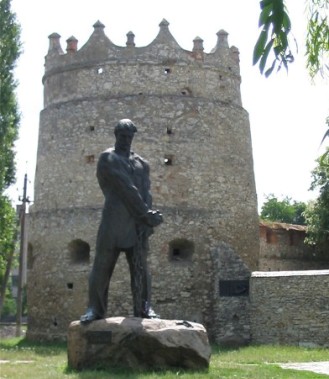

Location: Letychiv, Khmelnitskyi Oblast
Constructed: 1362
Letychiv castle is a castle in the urban-type village of Letychevy, the center of Letychiv district in the east of Khmelnytskyi region of Ukraine.
It is believed that in 1362, the Lithuanian princes Koriatovych built
a castle in Letychev. It is not known what that original fortress looked
like, but we can guess: it is unlikely that the local outpost was very
different from other Podil castles of those times - wooden walls, an
earthen rampart and a deep moat filled with water from the river. A
typical project of the Middle Ages.
1466 - King of Poland Casimir
IV Jagiellonian grants Letychev the right of Magdeburg, and the city is
mentioned as a stronghold on the way to Vinnytsia.
In 1579, Jan
Pototskyi, the headman of Kamianets, by order of the government, began
rebuilding the wooden and earthen castle into a stone one. It is
difficult to say whether this date is accurate (in the comments to the
well-known series of engravings by the Belarusian-Polish artist of the
19th century, Napoleon Horda, a different date for the construction of
the fortress is given: 1598). It is possible that the construction of
the castle began in 1579, and it was completed in just 19 years, because
the ambassador of King Rudolf II, Erich Lyasota, who reached Kyiv in
1594, wrote in his diary that he saw Pototsky Castle in Letychev on the
Vovk River.
The remains of that building, which represent the
military architecture of the Grand Duchy of Lithuania, have been
preserved to this day, namely, the castle walls along the entire
perimeter and one tower, the remains of which can be seen going along
the Vinnytsia-Khmelnytskyi highway. The large rectangular courtyard was
surrounded by high stone walls with embrasures, four round at the
corners and quadrangular entrance towers. From the side of the city, the
castle was protected by an earthen rampart with a palisade. A deep moat
with water ran between the castle walls and the rampart. This is how the
fortress is depicted on its first "portrait" - the map of the French
military engineer Guillaume de Beauplan. The outpost is surrounded by
two dammed ponds and another dam on the South Bug.
In 1606, Pavel
Volutskyi, bishop of the Kamianets RCC, built a Dominican monastery on
the castle grounds on the site of its predecessor - a wooden church that
had been mentioned since the middle of the 16th century (completed in
1638). The church houses an organ mentioned in 1637. 1720 - the bell
tower of the church was built.
In 1601, the city received the
status of the county center, and therefore was quite large. During the
Khmelnytskyi period, the Letichiv area belonged to the territory that
was initially controlled by the Cossack hetman, and after the signing of
the armistice (February 1649) by the Polish-Lithuanian Commonwealth.
1672 - Turks occupy the region. Passing from hand to hand, the city
gradually declines.
The "Polish Courier" for 1737 mentions the
Haydamaki detachments. In 1750, the rebels captured the city, which at
that time rose from the knees of ruins, grew and became rich. According
to the evidence of the Baal Shem Tov, the first Jews began to settle in
the city sometime in the same year. In 1765, Letychiv is mentioned as a
flourishing city. In the 1780s, about 800 Jews lived there.
As a
result of the second division of the Polish-Lithuanian Commonwealth in
1793, Letychiv was annexed to the Russian Empire. Russian Tsar Nicholas
I ordered to close the monastery as non-Orthodox.
1830s: the city was one of the centers of the uprising led by Ustym
Karmalyuk. Karmelyuk is buried in Letychev, near the tower in 1974 a
5-meter monument to Karmalyuk was erected.
In those days, the
Jewish population grew significantly — in 1897, about 4,100 Jews lived
here (60% of the entire population). From time to time, Jewish pogroms
took place in the city, in particular, in 1882, during the Bolshevik
revolution of 1917 and the civil war.
On July 17, 1941, Letychiv
was occupied by German troops. They set up a Jewish ghetto and a
concentration camp in the castle where they kept the city's Jews and
other prisoners. At the end of 1942, about 7,200 residents of the ghetto
were killed near the suburb of Zaletichivka. On March 23, 1944, it was
liberated by the troops of the Second Ukrainian Front of the Soviet
Army. A memorial plaque in honor of the Soviet soldiers who died in the
camp hangs on the ants near the tower. During Soviet times, it was
proposed to demolish the remains of the tower, but, fortunately, this
idea was not implemented.